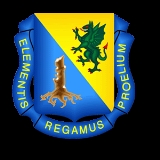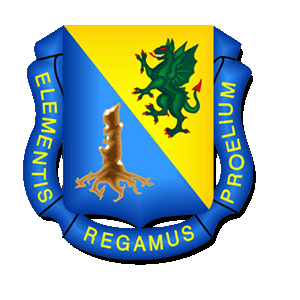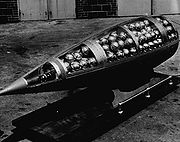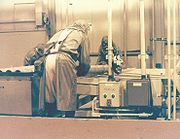
List of U.S. chemical weapons topics
Encyclopedia
The U.S.
chemical weapons program began during World War I
. Chemical weapons were only used during that war. Chemical weapons production ended in 1969. The United States renounced chemical weapons in 1997 and destruction of stockpiled weapons is still ongoing.

 Closed bases
Closed bases


 Agents stockpiled at the time of Chemical Weapons Convention:
Agents stockpiled at the time of Chemical Weapons Convention:
United States
The United States of America is a federal constitutional republic comprising fifty states and a federal district...
chemical weapons program began during World War I
World War I
World War I , which was predominantly called the World War or the Great War from its occurrence until 1939, and the First World War or World War I thereafter, was a major war centred in Europe that began on 28 July 1914 and lasted until 11 November 1918...
. Chemical weapons were only used during that war. Chemical weapons production ended in 1969. The United States renounced chemical weapons in 1997 and destruction of stockpiled weapons is still ongoing.
Army agencies and schools
The U.S. chemical weapons programs have generally been run by the U.S. Army:
- American Expeditionary Force Gas Service Section
- American Expeditionary Force Chemical Service Section
- U.S. Army Gas School
- U.S. Army Soldier and Biological-Chemical Command
- United States Army Chemical Corps, originally the Chemical Warfare Service
- United States Army Medical Research Institute of Chemical DefenseUnited States Army Medical Research Institute of Chemical DefenseThe United States Army Medical Research Institute of Chemical Defense is a military research institute located at Aberdeen Proving Ground, Maryland, USA, and is used by the United States Army for the development, testing, and evaluation of therapy and material to prevent and treat casualties of...
- U.S. Army Chemical Materials Agency
- United States Army CBRN SchoolUnited States Army CBRN SchoolThe United States Army CBRN School, located at Fort Leonard Wood, Missouri is the recognized world leader in training for military Chemical, Biological, Radiological, and Nuclear defense. In accordance with U.S...
Units
- Chemical mortar battalionChemical mortar battalionThe United States chemical mortar battalions were army units attached to U.S. Infantry divisions, and it was their responsibility to service the 4.2 in chemical mortar during World War II. For this reason they were also called the "Four-deucers"....
- 1st Gas Regiment1st Gas RegimentThe 1st Gas Regiment was the first established offensive chemical warfare unit in the United States Army. Beginning as the 30th Engineer Regiment in 1917, the regiment has been re-designated several times, most recently to the 2nd Chemical Battalion...
- 2nd Chemical Mortar Battalion2nd Chemical Mortar Battalion (United States)The 2nd Chemical Battalion is a United States Army smoke generation and decontamination unit stationed at Fort Hood, Texas, United States and is part of the 13th Sustainment Command...
Modern chemical depots
Active bases- Anniston Army DepotAnniston Army DepotAnniston Army Depot is a major United States Army facility fulfilling various depot operations. Primary missions are the repair of tracked vehicles and storage of chemical weapons . The depot is located in Bynum, Alabama....
with Anniston Chemical ActivityAnniston Chemical ActivityAnniston Chemical Activity is a U.S. Army chemical weapon storage site located in Alabama. The Army had stored approximately seven percent of the nation’s original chemical weapons stockpile at the Anniston Army Depot since the early 1960s. In August 2003, the Army began disposing of these weapons...
(stockpile destroyed 2011) - Blue Grass Army DepotBlue Grass Army DepotBlue Grass Army Depot is a U.S. Army conventional munitions and chemical weapon storage facility located in east central Kentucky, southeast of the cities of Lexington and Richmond, Kentucky, operated by the United States Army. The site, composed mainly of open fields and wooded areas, is used...
- Deseret Chemical DepotDeseret Chemical DepotThe Deseret Chemical Depot is a U.S. Army chemical weapon storage area located in Utah, 60 miles southwest of Salt Lake City. It is related to the Tooele Chemical Agent Disposal Facility.-History:...
with Tooele Chemical Agent Disposal FacilityTooele Chemical Agent Disposal FacilityThe Tooele Chemical Agent Disposal Facility or TOCDF, is a U.S. Army facility located at Deseret Chemical Depot in Tooele County, Utah and is used for dismantling chemical weapons. Destruction is a requirement under the Chemical Weapons Convention and is monitored by the Organisation for the... - Pueblo Chemical DepotPueblo Chemical DepotThe Pueblo Chemical Depot is a chemical weapons storage site located in Pueblo County, Colorado, United States.The depot houses 2,611 tons of mustard agent in approximately 780,000 munitions, equivalent to about seven percent of the original chemical material stockpile of the United States...
- Umatilla Chemical DepotUmatilla Chemical DepotThe Umatilla Chemical Depot, based in Umatilla, Oregon, was a U.S. Army installations in the United States that stored chemical weapons. The chemical weapons originally stored at the depot consisted of various munitions and ton containers containing GB and VX nerve agents and HD blister agent...
(stockpile destroyed 2011)

- Johnston Atoll Chemical Agent Disposal SystemJohnston Atoll Chemical Agent Disposal SystemJohnston Atoll Chemical Agent Disposal System was the U.S. Army's first chemical munitions disposal facility. It was located on Johnston Island, at Johnston Atoll and completed its mission and ceased operation in 2000.-Background:...
(closed 2000) - Edgewood Chemical ActivityEdgewood Chemical ActivityThe Edgewood Chemical Activity was a U.S. Army site located in Edgewood, Maryland that stored chemical weapons. Since 1941, the U.S. Army stored approximately five percent of the nation's original chemical agent in steel ton containers, at the Edgewood Area of Aberdeen Proving Ground...
at Aberdeen Proving GroundAberdeen Proving GroundAberdeen Proving Ground is a United States Army facility located near Aberdeen, Maryland, . Part of the facility is a census-designated place , which had a population of 3,116 at the 2000 census.- History :...
(closed 2006) - Hawthorne Army DepotHawthorne Army DepotHawthorne Army Depot is a U.S. Army ammunition storage site located near the town of Hawthorne in western Nevada in the United States. It is directly south of Walker Lake. The depot covers and has storage space in 2,427 bunkers...
(eliminated shells 1999) - Newport Chemical DepotNewport Chemical DepotThe Newport Chemical Depot, previously known as the Wabash River Ordinance Works and the Newport Army Ammunition Plant, was a bulk chemical storage and destruction facility in west central Indiana, thirty miles north of Terre Haute operated by the United States Army...
(closed 2008) - Pine Bluff Chemical ActivityPine Bluff Chemical ActivityPine Bluff Chemical Activity is a U.S. Army agency that controlled the chemical weapon storage site located at Pine Bluff Arsenal in Pine Bluff, Arkansas. The U.S. Army stored approximately twelve percent of its original chemical weapons at the Pine Bluff Arsenal since 1942...
(stockpile destroyed 2010)
Older chemical weapons program locations
- Camp American UniversityCamp American UniversityCamp American University was the name the U.S. military used for the segment of the Washington, DC main campus of American University during World War I and World War II....
- Camp LeachCamp LeachCamp Leach was the name the U.S. military used for the segment of the Washington, DC main campus of American University during World War I and World War II....
- Dugway Proving GroundDugway Proving GroundDugway Proving Ground is a US Army facility located approximately 85 miles southwest of Salt Lake City, Utah in southern Tooele County and just north of Juab County...
- Rocky Mountain ArsenalRocky Mountain ArsenalThe Rocky Mountain Arsenal was a United States chemical weapons manufacturing center located in the Denver Metropolitan Area in Commerce City, Colorado...
- Navajo Ordnance Depot
Treaties, laws and policy
The U.S. is party to several treaties which limit chemical weapons:- Chemical Weapons ConventionChemical Weapons ConventionThe Chemical Weapons Convention is an arms control agreement which outlaws the production, stockpiling and use of chemical weapons. Its full name is the Convention on the Prohibition of the Development, Production, Stockpiling and Use of Chemical Weapons and on their Destruction...
- Chemical Weapons Convention Implementation Act of 1998
- Executive Order 11850Executive Order 11850Executive Order 11850--Renunciation of certain uses in war of chemical herbicides and riot control agents. was signed on April 8, 1975, by United States President Gerald Ford....
- Executive Order 13049
- Executive Order 13128Executive Order 13128Executive Order 13128 is an United States executive order issued by Bill Clinton in 1999. It authorized the Departments of State and Commerce to create regulations regarding the implementation of the Chemical Weapons Convention.-Background:...
- Hague Conventions (1899 and 1907)Hague Conventions (1899 and 1907)The Hague Conventions were two international treaties negotiated at international peace conferences at The Hague in the Netherlands: The First Hague Conference in 1899 and the Second Hague Conference in 1907...
- Washington Arms Conference Treaty (Treaty relating to the Use of Submarines and Noxious Gases in Warfare. Washington, 6 February 1922.) - France prevented this treaty from coming into effect
- Geneva ProtocolGeneva ProtocolThe Protocol for the Prohibition of the Use in War of Asphyxiating, Poisonous or other Gases, and of Bacteriological Methods of Warfare, usually called the Geneva Protocol, is a treaty prohibiting the first use of chemical and biological weapons. It was signed at Geneva on June 17, 1925 and entered...
Weapons

Canceled weapon projects
While these weapon systems were developed, they were not produced or stored in the US chemical weapons stockpile.- BIGEYE bombBigeye bombThe Bigeye bomb was a proposed U.S. binary chemical weapon. The Bigeye was a glide bomb designed under the auspices of the U.S. Navy. Initially approved by the Carter administration, the program persisted into the early 1990s.-Background:...
- XM-736XM-736 8-inch projectileThe XM-736 8-inch projectile was a binary howitzer round that was designed to carry the nerve agent VX. After the suspension of the testing in 1982, models indicated the shell could be unstable in flight due to the liquid properties of VX. However, instabilities were not observed during earlier...
8-inch binary projectile
Vehicles
- LCI(M), infantry landing craft armed with 4.2 in mortar
- M1135 Nuclear, Biological, Chemical, Reconnaissance VehicleM1135 Nuclear, Biological, Chemical, Reconnaissance VehicleThe M1135 Nuclear, Biological, Chemical Reconnaissance Vehicle provides nuclear, biological and chemical detection and surveillance to supply battlefield visualization of hazards.- Design :...
, a variation of the StrykerStrykerThe IAV Stryker is a family of eight-wheeled, 4-wheel-drive , armored fighting vehicles derived from the Canadian LAV III and produced by General Dynamics Land Systems, in use by the United States Army. The vehicle is named for two American servicemen who posthumously received the Medal of Honor:...
vehicle - M93 FoxM93 FoxThe Fox vehicle is a chemical, biological, radiological, and nuclear reconnaissance vehicle. This vehicle is a variant of the German TPz1 Fuchs manufactured by Rheinmetall to survive and provide reconnaissance on a CBRN-affected battlefield...
- SD-2 drone
Declared stockpile and other weapons
- M1 chemical mineM1 chemical mineThe M1 was a U.S. chemical landmine. It developed in 1939, and consisted of a one gallon gasoline can filled with 9.9 lbs of mustard gas agent. As issued, it had no bursting charge or fuze, but required a bursting charge of detonating cord to be attached via soldered tabs on the outside of the...
- M1 chemical bomb
- M10 smoke tankM10 smoke tankThe M10 smoke tank was an aircraft under wing tanks used by the United States Army Air Force to lay smoke screens or dispense chemicals such as tear gas...
- M104 155mmM104 155mm CartridgeThe M104 155mm Projectile was a chemical artillery shell designed for use by the U.S. Army. It was specifically designed to carry about 11.7 pounds of sulfur mustard H or HD blister gas....
shell - M110A1/A2 155mmM110 155mm CartridgeThe M110 155 Projectile is a chemical artillery shell used by the U.S. army. Today, variants of the original shell are used for marking, signaling, and screening purposes...
shell - M114 bomblet
- M121/A1 155mmM121/A1 155mm CartridgeThe M121/A1 155mm Projectile was a chemical artillery shell designed for use by the U.S. army. It was designed to be used with approximately 6.5 lbs of GB or VX nerve agents....
shell - M122 155mmM122 155mm CartridgeThe M122 155mm Cartridge was an chemical artillery shell designed to carry 6.5 lbs of a nerve agent, specifically Sarin ....
shell

- M125 bombletM125 bombletThe M125 bomblet was a U.S. chemical sub-munition designed to deliver the nerve agent sarin. It was brought into service in 1954 with the M34 cluster bomb as part of the first U.S. air-delivered nerve agent weapon.-History:...
, (developed as E54R6) chemical bomblet used with M34A1 cluster bomb - M134 bombletM134 bombletThe M134 bomblet was a U.S. chemical sub-munition designed for use in the Honest John rocket during the 1950s. The weapon was never mass-produced and was supplanted in 1964 by an improved design, the M139.-History:...
, (developed as E130R1), chemical bomblet for use with Honest John rockets - M138 bombletM138 bombletThe M138 bomblet was a sub-munition of the U.S. chemical weapon, the M43 BZ cluster bomb. The bomblet contained BZ, an incapacitating agent and was developed with the M43 in 1962. The M138s, along with all other U.S. BZ weapons were destroyed during the 1980s....
, sub-munition for the M43 cluster bomb - M139 cluster bomblets for the MGR-1 Honest JohnMGR-1 Honest JohnThe MGR-1 Honest John rocket was the first nuclear-capable surface-to-surface rocket in the US arsenal.The first nuclear-authorized guided missile was the MGM-5 Corporal. Designated Artillery Rocket XM31, the first such rocket was tested 29 June 1951 and the first production rounds were delivered...
rocket and other missile systems - M2 mortarM2 MortarThe M2 Mortar is a smoothbore, muzzle loading, high-angle-of-fire weapon used by U.S. forces in World War II, the Korean War, and the Vietnam War for light infantry support.-Description:...
shell (M2A1) for the M2 4.2 Inch MortarM2 4.2 inch mortar-External links:* early detailed article on 4.2 mortar... - M23 chemical mineM23 chemical mineThe M23 is a U.S. steel cased chemical landmine. The mine was developed in the late 1950s and early 1960s and approximately 100,000 were produced. The U.S...
- M34A1 cluster bomb (developed as E101R3), first U.S. air-delivered nerve agent weapon
- M360 105mmM360 105mm CartridgeThe M360 105mm Cartridge was a chemical artillery shell designed for use the by U.S. Army. It carried approximately 1.6 pounds of GB....
shell - M426 8-inch shellM426 8-inch shellThe M426 8-inch shell was a chemical artillery shell designed for use by the U.S. Army. It was designed to be used with approximately 14.5 lbs of GB or VX ....
- M43 cluster bomb
- M44 generator clusterM44 generator clusterThe M44 generator cluster was an American chemical cluster bomb designed to deliver the incapacitating agent BZ. It was first mass-produced in 1962 and all stocks of the weapons were destroyed by 1989.-History:...
- M47 bombM47 bombThe M47 bomb was a chemical bomb designed during World War II for use by the U.S. Army Air Forces.-Design:The bomb was designed for aerial bombardment and maximum efficiency after being dropped. Therefore, the bomb had a very thin metal sheet as its only cover, as little as 1/32 of an inch. The...
, 100 lb. World War II-era chemical bomb - M55 rocketM55 rocketThe M55 rocket was a chemical weapon developed by the United States in the 1950s. The United States Army produced both Sarin and VX unitary warheads for the M55.-History:...
- M6 canister, BZ sub-munition for the M44 generator cluster
- M60 105mmM60 105mm CartridgeThe M60 105mm howitzer cartridge was a U.S. artillery shell that carried a chemical agent, specifically one of the sulfur mustard agents....
shell - M687 155mmM687The M687 is an American 155 mm binary sarin chemical weapon artillery shell. The design was standardized in 1976 and production began on December 16, 1987 at Pine Bluff Arsenal, Pine Bluff, Arkansas...
shell - MC-1 bombMC-1 bombThe MC-1 bomb was the first U.S. non-clustered air-dropped chemical munition. The MC-1 was first produced in 1959 and carried the nerve agent sarin.-History:...
- Mk 94 bomb
- Mk 95 bomb
- Weteye bombWeteye bombThe Weteye bomb was a U.S. chemical weapon designed for the U.S. Navy and meant to deliver the nerve agent sarin. The Weteye held 160 kg of liquid sarin and was officially known as the Mk 116...
, also known as the Mk-116 bomb
Stockpiled chemical agents

- isopropyl aminoethylmethyl phosphonite, or QL, part of a binary weapon (VX)
- Methylphosphonyl difluorideMethylphosphonyl difluorideMethylphosphonyl difluoride , also called methyl difluorophosphite, methylphosphonic difluoride, and difluoromethylphosphine oxide, is a chemical weapon precursor. It is a Schedule 1 substance in the sense of the Chemical Weapons Convention...
(known to the military as DF) and a mixture of isopropyl alcohol and isopropyl amine (known as OPA), a binary chemical weaponBinary chemical weaponBinary chemical weapons or munitions are chemical weapons wherein the toxic agent is not contained within the weapon in its active state, but in the form of two chemical precursors, physically separated within the weapon...
(sarin) - Mustard gas
- SarinSarinSarin, or GB, is an organophosphorus compound with the formula [2CHO]CH3PF. It is a colorless, odorless liquid, which is used as a chemical weapon. It has been classified as a weapon of mass destruction in UN Resolution 687...
(GB) - VXVX (nerve agent)VX, IUPAC name O-ethyl S-[2-ethyl] methylphosphonothioate, is an extremely toxic substance whose only application is in chemical warfare as a nerve agent. As a chemical weapon, it is classified as a weapon of mass destruction by the United Nations in UN Resolution 687...
Operations and exercises
- Operation Blue Skies
- Operation CHASEOperation CHASEOperation CHASE was a United States Department of Defense program that involved the disposal of unwanted munitions at sea from May 1964 into the early 1970s....
, an operation that dumped conventional and chemical munitions at sea - Operation Davy Jones' LockerOperation Davy Jones' LockerOperation Davy Jones' Locker was a U.S. military operation from 1946-1948. It involved the dumping at sea of captured German chemical weapons following the end of World War II.-Background:...
, a post-WWII operation aimed at dumping German chemical weapons at seas - Operation GeraniumOperation GeraniumOperation Geranium was a U.S. Army mission that dumped more than 3,000 tons of the chemical agent lewisite into the ocean off the Florida coast in 1948.-Operation:...
, a 1948 operation that dumped lewisiteLewisiteLewisite is an organoarsenic compound, specifically an arsine. It was once manufactured in the U.S. and Japan as a chemical weapon, acting as a vesicant and lung irritant...
into the Atlantic Ocean. - Operation PaperclipOperation PaperclipOperation Paperclip was the Office of Strategic Services program used to recruit the scientists of Nazi Germany for employment by the United States in the aftermath of World War II...
, a program beginning in 1945 to bring German scientists to the U.S. - Operation Ranch HandOperation Ranch HandOperation Ranch Hand was a U.S. Military operation during the Vietnam War, lasting from 1962 until 1971. It was part of the overall herbicidal warfare program during the war called "Operation Trail Dust"...
, defoliant operations during the Vietnam War - Operation Red HatOperation Red HatOperation Red Hat was a U.S. military action taking place in 1971, which involved the movement of chemical warfare munitions from Okinawa, Japan to Johnston Atoll in the North Pacific Ocean.-Operation:...
, an early 1970 program to repatriate weapons from Okinawa - Operation Rock Ready, 1980’s testing and rebuilding of the M17 series protective mask
- Operation Snoopy, Vietnam War people snifferPeople snifferPeople sniffer was the field name for a series of U.S. Army personnel detectors used during the Vietnam War. The purpose was to detect enemy soldiers in hidden positions, which were often employed in the jungle combat conditions of Vietnam. The U.S...
operations. - Operation Steel BoxOperation Steel BoxOperation Steel Box, also known as Operation Golden Python, was a 1990 joint U.S.-West German operation which moved 100,000 U.S. chemical weapons from Germany to Johnston Atoll.-Background:...
, an operation which moved chemical weapons out of Germany in 1990.
Accidents
- Bombing of the SS John Harvey during the Air Raid on BariAir Raid on BariThe air raid on Bari was an air attack by German bombers on Allied forces and shipping in Bari, Italy on 2 December 1943 during World War II. In the attack, 105 German Junkers Ju 88 bombers of Luftflotte 2, achieving complete surprise, bombed shipping and personnel operating in support of the...
- Dugway sheep incidentDugway sheep incidentThe Dugway sheep incident, also known as the Skull Valley sheep kill, was a 1968 sheep kill that has been connected to United States Army chemical and biological warfare programs at Dugway Proving Ground in Utah...
Chemical testing
- Edgewood Arsenal experimentsEdgewood Arsenal experimentsThe Edgewood Arsenal experiments are said to be related to or part of CIA mind-control programs after World War II, such as MKULTRA. Journalist Linda Hunt, citing records from the U.S...
- MK ULTRAMk UltraMk Ultra was an American alternative band that played between 1994 and 1999. The group formed in the Bay Area in the early nineties and went on to become a hit in local circles. Mk Ultra's career culminated in a national tour in 1999 but came to a rapid end when guitarist John Tyner decided to...
, the CIA-led program to test various chemicals - Operation LACOperation LACOperation LAC , was a U.S. Army Chemical Corps operation which dispersed microscopic zinc cadmium sulfide particles over much of the United States. The purpose was to determine the dispersion and geographic range of biological or chemical agents.-Earlier tests:There were tests that occurred prior...
, (Large Area Coverage), 1958 test that dropped microscopic particles over much of the United States - Operation Top HatOperation Top HatOperation Top Hat was a "local field exercise" conducted by the United States Army Chemical Corps in 1953. The exercise involved the use of Chemical Corps personnel to test biological and chemical warfare decontamination methods...
, a 1953 Chemical Corps exercise testing decontamination methods on human subjects - Project SHADProject SHADProject SHAD stands for Project Shipboard Hazard and Defense, a series of Cold War-era tests by the United States Department of Defense of biological weapons and chemical weapons...
See also
- List of U.S. biological weapons topics
- United States and weapons of mass destructionUnited States and weapons of mass destructionThe United States is known to have possessed three types of weapons of mass destruction: nuclear weapons, chemical weapons and biological weapons. The U.S. is the only country to have used nuclear weapons in combat. The U.S. also used chemical weapons in World War I...

